|
|
|
|
| INITIAL INSPECTION & REPORT requires a complete thorough inspection of the buildings and surrounds, and a detailed written report on areas inspected, evidence found of termite activity, high risk termite entry areas inaccessible to inspection and termite control options and limitations thereto. Recommended as
essential.
|
| CHEMICAL SOIL TREATMENT
around the perimeter and sub-floor of a building to eradicate termites attempting
to gain entry into the building through a treated soil area. On the grounds
of safety and effectiveness Termidor
or Premise
termiticide, are recommended for this purpose - discussed in detail later
in this website.
|
| TERMITE BAITING and potential TERMITE COLONY
ELIMINATION involves the installation
and monitoring of termite bait stations, such as Exterra
and Sentricon systems. This method relies heavily on the termites "finding"
and consuming sufficient bait. Recommended in some circumstances.
|
| BUILDING MODIFICATIONS and MAINTENANCE including some termite risk reduction measures the homeowner carry out,
such as, improving sub-floor ventilation, removal of timber in contact with the soil, opening and clearing important inspection access areas.
|
| Regular FOLLOW-UP INSPECTIONS are essential and should be carried out at least every 3 to 6 months where signs of termite activity has been located in the vicinity of susceptible buildings or timber structures. |
|
|
| FIRSTLY, it is essential for the termite controller to complete a thorough
inspection of the buildings and surrounds. The property owner should be
supplied with a written inspection report and detailed specifications for
an integrated termite control program. It is essential that the inspection
and report be received before any protective measures are commenced.
A professional termite inspection and report, including a termite control protection advice costs vary depending on the size of the house and the style of construction and ease of inspection access. |
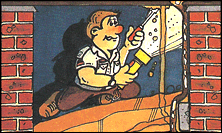
|
A professional termite inspection and report could save
you thousands of dollars.
Specific areas inspected should include accessible timbers within the crawl space in the sub-floor, roof void, interior, exterior, garden landscaping, fences, other timber structures and trees in the locality. |
|
|
| CONSUMER NOTE: Most home-owners are unaware that their general home
insurance policy does NOT cover termite damage to structural timbers. However, appropriate
professional indemnity insurance is available to professional pest controllers
to cover termite damage to structural timbers in a building caused by subterranean
termites gaining entry into the building through an abutting chemical soil
treated area.
If there are termites in the building, at the time of chemical soil treatment, they cannot safely return to their central colony nest through the chemically treated soil. Termites are compelled to return every few days to their central colony nest in the ground to obtain moisture essential for their survival and to feed and groom the nymphs (young termites), the king, queen and other termites. The installation of a chemical soil barrier requires expert knowledge and specialized equipment to form a complete and continuous barrier to protect the building from a termite entry and infestation - as illustrated below: |
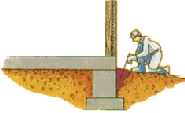
|

|
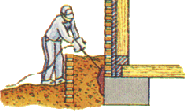
|
|
|
|
|
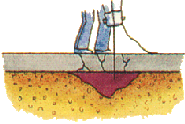
|
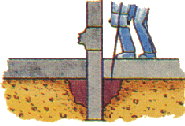
|
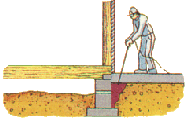
|
|
|
|
|
Subterranean termites may build such a nest in a roof or wall cavity where moisture is regularly supplied, say from a leaking shower recess, broken roof tiles, faulty guttering or plumbing. |
|
|
| There are several types of termite control chemicals registered by the relevant State and/or Federal Government Authority for use in termite control as a soil treatment chemical. |
WARNING: Several outdated products are solvent
based termite control pesticides which may cause health problems to asthmatics
during the drying process.
|
Termidor and Premise
do NOT have an obnoxious odor or emit airborne residues or fumes. Both
are registered as a low hazard insecticide with a CAUTION notation on
the registered label.
|
Some alternative termiticides have a strong repellency action to deter
foraging termites. Whereas Termidor and Premise
are non-repellant to the termites. Termites can enter the treated soil zone
without detecting the Termidor or Premise chemical. The repellant nature
of other products mean the termites can detect the chemical and will move
along the treated soil areas, actively seeking a gap to gain entry into
the building.
Premise will act to kill termites, in the higher concentration treated soil areas abutting the building. With Premise, termites that forage in the lower concentrated treated soil areas, will become disorientated, stop feeding, and are fatally diseased by natural fungi and micro-organisms in the soil. |
| Both Bayer Premise
and BASF Termidor claim their products will
transfer from one affected termite to another ... the technology aimed at
eradicating the queen termite and the entire colony - refer to the animated
illustration below:
|
After 250 million years of living underground, subterranean termites have evolved with a very thin waxy skin (called an exoskeleton) that readily absorbs moisture. The Premise active adheres to the termite exoskeleton and is readily adsorbed through the exoskeleton and into the termite's body to immobilize and kill the affected termite within a few days. The termites spread the Premise to other termites during regular physical contact, particularly when working together in close proximity, grooming and feeding the rest of the colony, a regular function of their daily life. Termites carry away or cannibalize other dead termites, further spreading the deadly effect of the Premise chemical throughout the colony. |
|
|
|
An insect growth regulator affects termites by stopping the molting process required for the termites to grow. As the worker termites die off, the termite colony declines to the point where it can no longer sustain itself, ultimately leading to it's collapse and elimination. The Exterra termite monitoring and baiting system is owned by Ensystex, USA. The Exterra termite bait is also an insect growth regulator. Both Sentricon and Exterra systems have their own plastic bait stations which must be used with their product. These bait stations can be placed in the ground and checked regularly. Termite colony elimination in favorable circumstances may take several weeks to a few months. However, in some cases, termite colony elimination is unsuccessful or may take years, depending on the circumstances. Where a large number of termites find and consume the bait, then colony elimination is virtually assured within a few months. This is where the experience and skill of the termite controller is paramount to decide if and where a baiting program is implemented and properly monitored. Both the Sentricon and Exterra termite baits are designed to be slow acting, non-repellant and therefore spread to other termites in the colony before the colony can detect where the deadly effect is coming from. Termites have acute survival instincts. The location of a toxic food source if detected, will be abandoned. Too much disturbance of the foraging termites (workers and soldiers) in a particular location, will alert the termite colony to abandon the area. The termites appear to be gone, but may in fact be entering the building in other areas. Your home is a much bigger bait station. Both the Exterra and Sentricon termite baiting systems are subject to regular inspection and monitoring by the termite controller. The larger the number of termites that consume the bait, the quicker and more certain is the termite colony elimination process. It is usual to re-inspect the bait stations and the buildings and surrounds every month to reposition, reapply or replenish the bait, if necessary. This process is labor intensive so that the long term cost of the monitoring / baiting system may accumulate out of hand before the chance of success or otherwise, is realized. |
 |
Ring the Experts: successful
termite protection of a building using a baiting program often requires
expert skill and judgment, based upon years of field-work experience in
termite control in a wide variety of circumstances.
One critical aspect is the bait stations should to installed in areas where termites are more likely to be foraging. The termites must "find" the stations to have any chance of success. |
| CONSUMER NOTICE: Be wary of any advertising or promise that a timber replacement warranty applies as regards subsequent termite damage to a building using a termite colony elimination system. For example, some pest control companies promote a $100,000 Timber Replacement Warranty as regards to the use of a particular "termite colony elimination" system - but be careful to read the Contract carefully! Does this Contract stipulate in the fine print that the so called "warranty" may (or may not) apply at some future point in time to be decided by the company? |
The Sentricon baits are placed in their in-ground bait stations after removal of the termite infested timber therein. This may involve sufficient disruption of the termites such that they avoid the in-ground Sentricon bait station, entirely. This serious short-coming is overcome by the patented Exterra Termite Stations where the timber is aligned around the cylinder such that the bait can be inserted without such disturbance of the termites present. RECOMMENDATION: Exterra or Sentricon be used where a complete chemical soil barrier treatment using Termidor or Premise is not practicable or desired, and where a several thousand termites are likely to eat the bait. A termite monitoring and baiting program can be integrated with a range of methods including (1) drilling susceptible trees and eradication of any termite nest located therein, and (2) in conjunction with a follow up chemical soil treatment using Termidor or Premise. |
|
|
| Rapid termite colony development and building infestation is usually
associated with a readily available timber food and moisture source nearby
the central nest. In addition, buildings are often
constructed in a way that allow termites to gain undetectable entry from
the soil to the structural timbers of the building. Listed below are some
useful recommendations for the home owner to carry out in order to reduce
the risk of termite activity inside a building. Moisture exclusion from inside the wall cavities, around the base of the building and sub-floor area (if any). Water run-off can be excluded from a sub-floor area by the installation of ag-drains. Make sure there is adequate cross flow ventilation in the sub-floor area. In addition, a qualified plumber should be engaged to ensure there is no water leakage from plumbing pipes in the bathroom, the shower recess, kitchen, down pipes, guttering and air conditioning unit overflow. Look for signs of dampness in the wall cavities, broken roof tiles, faulty guttering and the like. Please note: high humidity, dampness or moisture accumulating in a wall cavity is of high risk to encouraging large scale termite activity inside the building. Removal of any timber in contact with the soil. Timbers should be stored above ground to allow full inspection of subterranean termite activity (coming from the soil thereunder). Any landscaping using timber chip mulch and railway sleepers should definitely be removed, as they provide ready food source to assist in rapid termite colony development. Ensure inspection access is unimpeded, particularly in sub-floor areas (suspended floors) in order to look for evidence of termite activity. If your property is on a concrete slab on ground flooring, make sure you can inspect the entire external slab edge for evidence of termite mud-shelter tubes. Do NOT allow this area to be covered by pavers, landscaping, planter pots, etc, as termites often gain entry into the walls of a building via this locality, particularly through external weep holes and minute gaps in the mortar in brick-work. If you find live termites or termite damaged timbers DO NOT disturb the area. DO NOT use spray can or insecticides on the termites. If sufficiently disturbed, the termites are likely to move elsewhere, and may not be rediscovered until further obvious damage has been done. The termite controller can introduce Intrigue termite dust or Exterra termite bait directly to the live termites present in an attempt to eliminate the entire termite colony - as discussed in detail above. |
|
|
We usually recommend 3 or 6 monthly inspections be carried for the first 24 months following a chemical soil treatment. Monitoring of "stand-alone" baiting systems should be carried out every 4 to 6 weeks. |
| A Word of Warning: the correct identification of a destructive termite species, inspection of a building for tell-tale signs, analysis of your circumstances and the design and implementation of an effective program for the protection of a building from termite infestations, requires expert skill and judgment based upon professional training and extensive field-work experience in termite control in a wide variety of circumstances. |
|
|
| |